Sun (neema in Tibetan) blasts into the day as we wake to a reckless blue sky and a wind that hums. Snow capped peaks shimmer on the horizon and wind whips smoke and sand into mini-tornadoes.
All of Mother Nature’s elements are on display today in a show of force, and Michael and I both feel this bodes well for the journey. The city of Maqen (3700 metres) scatters for cover from winds that rip down the main street daring any to test it. Eyes burn from the suns rays and all of the goodies that the wind picks up and throws.
 Wind horse flags (long da) billow at 3700 metres
Wind horse flags (long da) billow at 3700 metres
Much of expeditions or indeed any travel, involves waiting. Waiting for weather, for the right guides, for the correct directions…in this case we are waiting for word of our team, one member in particular, who can add a rare perspective on our journey.
One of my great desires is finally confirmed beyond a doubt today as we are greeted with the welcome news that one of the last of the Salt Road traders will in fact travel with us as our unofficial guide. Up until now this has been a slight question mark because of his health and age, but his desire has and is strong to accompany us. In his seventies, he and he alone, it seems, knows the ancient Salt Road portion that passes through the nomadic lands and that which we seek to travel. There is only one condition to him joining us and that is that he has a horse to ride during the journey. In his almost apologetic words, “my body, though once strong, is no longer capable of walking the route”. We are delighted as much of the younger generation has no idea of the Tsalam (Salt Road), and sadly seem to care less, and with him we are sure to get tidbits, tales and that crucial must, an innate knowledge gained from actually travelling the route.
Today I am also issued another warning about wolves. “They are out in great numbers in recent years, and they are far smarter than you”, a local tells me directly. I’ve no doubt about his information, as years back in this region I was to witness a site that remains in my memory bank still. Trekking through a remote portion near Golok, a friend and I watched a pack numbering almost two-dozen strong, rip into a flock of sheep with an efficient ferocity that was riveting. The act that unfolded was both brutal and impressive in both strategy and execution.
Michael and I are urged in the bright rays of the sun this morning to visit the local monastery, which sits as a tribute to another traveler: a monk who traipsed all over the Tibetan Plateau by foot with little more than a bag of tsampa (ground barley), some butter and a bit of tea (which of course set him high in my books).
We are told that to begin our journey through these stoic and staggering landscapes we should visit and appease the local deities and pay a gentle homage to the lands and beliefs that we now find ourselves. I’ve long felt that these little gestures set something in the mind at peace, a kind of genuflection of respect to local forces, however secular or otherworldly they might be.
The monastery is more a series of small monasteries sitting at the north end of town, stupas, and flat-topped homes. All of this surrounds a huge mound of dirt hectares in size, which still now, is only now rediscovering life after a brutal winter. Prayer flags (loong da) cover the entire northwest face, flapping and billowing in winds that gain strength the higher we ascend.
Small pods of local Tibetan women slowly circumambulate the monastery and giant flag covered hill and we follow. Their pleated braids of hair run a metre down their backs. Features reveal a life living in concert and struggle with the earth’s forces. Their faith is something that requires a very physical effort. Their holy places must be ascended to, their bodies must find strength to visit and appease these places and spirits and all the while Mother Nature’s spectacular offerings are on display. Prayers and mantras are murmured in the full brunt of the winds and sun. Whether they are heard or not doesn’t seem the point, it is the fact that they are uttered at all which matters to the faithful.
Michael and I follow slowly, trudging along the reddish earth path. Our words, when spoken are ripped from our mouths by the wind. This isn’t a place for anything verbally obtuse. It is a place to move, to feel, to listen and sometimes it is a place to feel awe.View south
For traders along the ancient trade routes monasteries throughout the Himalayas provided sanctuary as well as (in locals minds at least) a modicum of protection on the long journeys. Before and after journeys, the lados (muleteers) of the caravans would visit to pray for safety and thanks.
We arrive back to a meal and that slightly pleasant feeling that the sun leaves on fresh skin.
Our dinner is composed of goat soup with spinach, noodles and enough garlic to lay any bacteria low. Vegetables will be scarce if at all in the coming days.

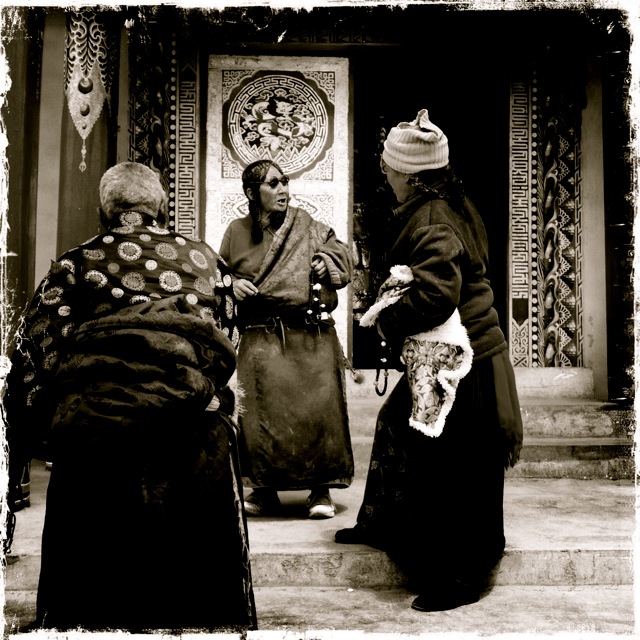
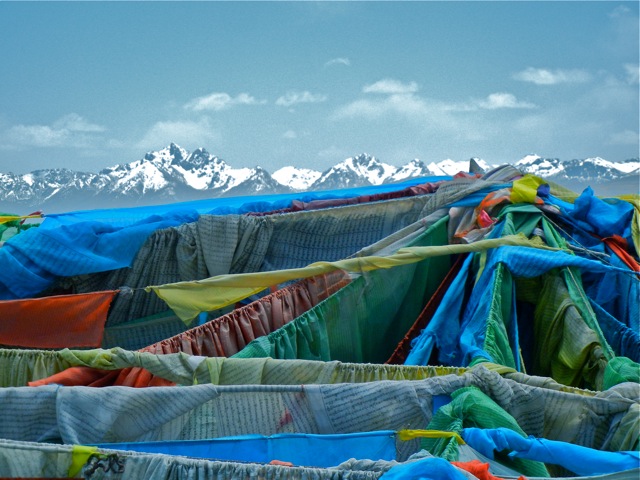
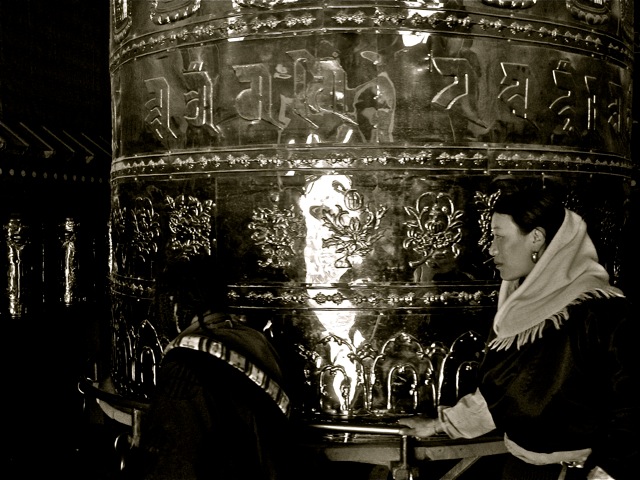
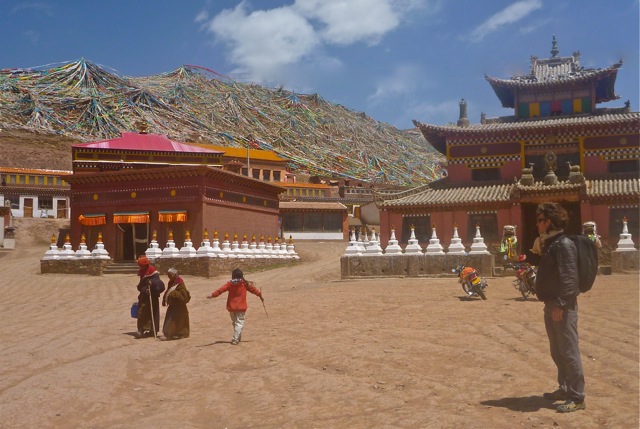
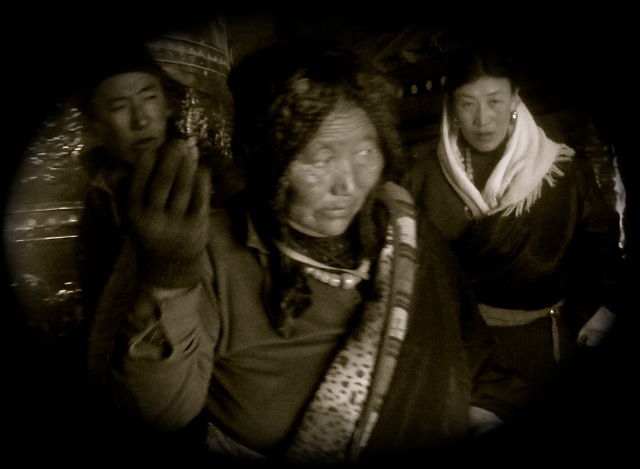

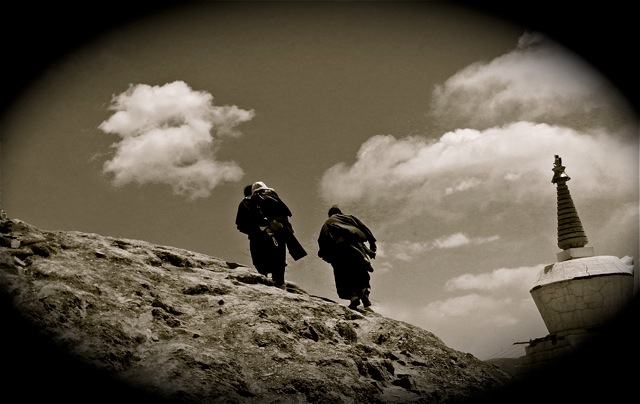
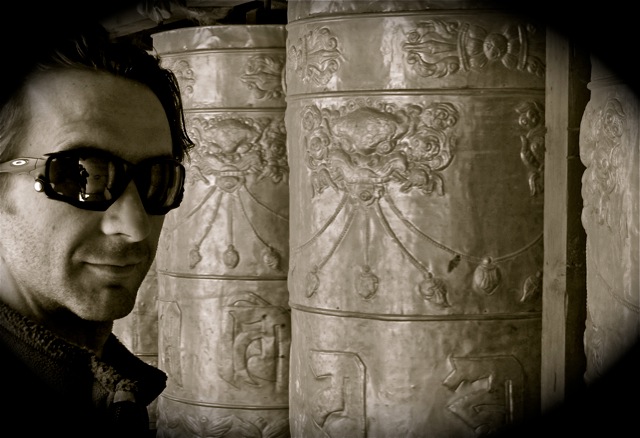

Hi Jeff,
We are thoroughly enjoying your articles and photographs. It took us a bit to figure out that the colourful flags where prayer flags – they are stunning. How long do they take to make? We would love to know more about them. Also, Enya wanted to know if you are ever not welcomed because you are a Westerner? Keep safe and we look forward to the next update.
Warmly, Gen
Hi Class…and Enya, and of course teacher Gen,
Prayer Flags are often taken and tied on mountain peaks or holy sites here in the Himalayas. Particular water ways, lakes, mountain and trees (when they are present) all qualify as holy sites. What makes these sites auspicious depends – some are designated holy by lama’s, some are supposedly the site of some event and some, due to their age or size also make the list. Most often the flags are found in white, green, yellow, blue and red, but are not hard to make and are available in most stores or homes that surround a monastery. Some of the ‘strings’ of prayer flags extend a couple hundred metres and are wrapped around a rock or hill.
Often when climbing in the past through remote areas, I would summit a peak and find that prayer flags were already there fluttering in the wind. Some pilgrim had already ascended to demarcate a specific peak – humbling to see and realize the effort required. When the caravans passed over snow-passes or difficult climbs traders would often take the flags with them and link them up over a peak as a thank you to the deities for successful passage. They would also scream (and many travellers and even drivers still do), “Lagyalo” (victory to the deities), which also meant victory to us mortals for having made it. We also intend to continue this tradition….though I will be sure to add a well-voiced scream of thanks to the tea gods as well.
Hope this helped.
Jeff
Great to hear that you have an original tsalam trader with you. Please pass along some (or all!) of the tidbits and tales that he is sure to relate.
And please be careful of those wolves, especially if they tavel (and attack) in packs of 2 dozen.
Best wishes,
Peter
Will be definitely posting his tidbits as it is these insights which give lifeblood to the route and the region. As for the wolves, if all else fails, I shall offer some tea and see where that gets us….
Jeff
My grade 10 class is now up to date with your blogs and they also have a question. Matt was wondering if you are aware of any history or ancient stories about the areas you are travelling.
Thanks again for your communication – we really appreciate your time.
Hi Matt,
for stories definitely check out King Cesar and his near mythological status – as it gives much insight and reads like an adventure tale.
Jeff